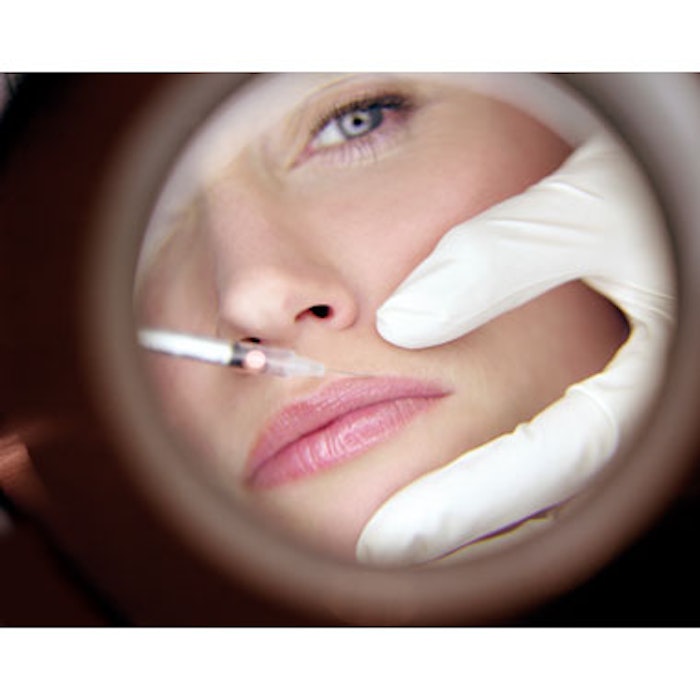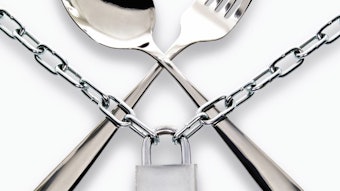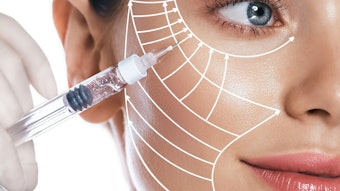
“Marketing your expertise with lips is a very successful practice enhancer,” says cosmetic dermatologist Stephen H. Mandy, MD, of South Beach Dermatology in Miami Beach, Florida. That’s not surprising given the focus many people put on the lips. Though the eyes may be one of the first areas to show signs of aging, the allure of sultry, full lips continues to drive young and older patients alike to seek cosmetic enhancement for the perioral area.
The challenge for physicians is creating natural-looking lip enhancement while also identifying the best tools to address surrounding concerns, such as perioral rhytides, marionette lines and deepening nasolabial folds. “The perioral area can be simple in young patients and complex in older patients,” says Richmond, Virginia-based facial plastic surgeon Joseph Niamtu III, DMD.
A Full-Face Approach
Improving and enhancing the lip area requires physicians to take into account both the patient’s treatment goals and existing anatomy. Hence, a thorough pretreatment evaluation is essential for optimal outcomes.
“When I assess lips, I first ascertain the goal of treatment. For example, if the goal is to provide structural change, such as significant lip eversion, then a product with good lift capacity is essential,” says Vince Bertucci, MD, president elect of the Canadian Dermatology Association and medical director of Bertucci MedSpa in Woodbridge, Ontario, Canada. “On the other hand, if lip shape is already satisfactory but there is volume loss leading to superficial rhytides within the vermilion of the lip, then a finer product such as Restylane Silk (Galderma) or Juvederm (Allergan) might be a better choice.”
He stresses that lips must be evaluated in relation to the entire face. “The lips do not exist in isolation. Balance, harmony and proportion must be primary considerations when contemplating lip augmentation and perioral rejuvenation,” says Dr. Bertucci. “For example, it would be inappropriate to create very large lips in an individual with a small face.”
He notes that it is not uncommon for younger patients, especially those in their 20s, to request lip enhancement that is out of proportion to the rest of the face. “Thus, we often have to educate patients about the importance of balance, harmony and proportion when addressing lips,” he says. “Representative before and after photos go a long way in showing prospective patients that lips may be enhanced in a tasteful manner. For physicians, recognizing what is and isn’t possible and setting realistic expectations is just as important as mastering injection techniques.”
When a patient comes to Day Dermatology & Aesthetics in New York City for lip treatment, Doris Day, MD, who specializes in aesthetic, laser and surgical dermatology, first asks the patient to smile. “I want to see the structure of their teeth. Lack of dental support, such as teeth that angle inward and therefore do not provide enough support for the lips can lead to major problems in the perioral area,” she says. “I also look at the position of the lips at rest. Lots of women have a habit of pursing their lips, and nothing we do will work for long if they don’t break that habit. I tell them that lips should only touch when kissing.” She counsels patients to stop smoking and stresses the importance of good skin care. “It is important to practice good skin care. Ongoing use of products with active ingredients like growth factors and retinols can have a significant impact,” says Dr. Day.
Photo copyright Getty Images.
[pagebreak]
For older patients, the degree of age-related volume loss and sun damage will affect treatment choice. “For mild cases of perioral rhytides, soft tissue fillers are often sufficient,” says Dr. Bertucci. “However, for more severe perioral wrinkles, I find that combination therapy with fillers, neuromodulators and laser resurfacing provides the best outcome.”
But factors other than age will influence treatment choice. “Cost and recovery time are also major considerations. Some patients may opt for aggressive CO2 laser treatments with two weeks of healing, whereas other patients may only have a lunch hour for recovery,” says Dr. Niamtu. “When a patient presents with multiple perioral aging factors and says, ‘I can only afford one syringe,’ I tell these patients to save their money and return when they can afford the necessary volume of filler.”
Dr. Day’s treatment approach is to gain an understanding of why the wrinkles are there and then use the simplest, least invasive method to correct them. “I consider the whole face first. If there’s a lot of volume loss in general, lifting the midface can change the way the mouth is used. If there is a lot of sun damage, laser resurfacing is helpful—we don’t treat the perioral area in isolation,” she says. “Ablative fractional resurfacing works best, but some patients may balk at the five days of downtime required. We use the UltraPulse Fractional CO2 laser (Lumenis). But patients will usually be dissatisfied unless you do something to address the perioral area directly if that’s their main area of concern.”
Lip Augmentation
The newest treatment tool for lip augmentation is Restylane Silk. The hyaluronic acid-based filler is FDA approved specifically for lip enhancement and the treatment of wrinkles and lines around the mouth in people over the age of 21.
“I have been hesitant to use fillers in the perioral area in the past because it was difficult to get a natural-looking result,” says Dr. Day. “Earlier fillers added too much bulk. Now, with Restylane Silk, I find I can support the tissue around the mouth and remove the look of tension while maintaining a natural, soft look. Restylane Silk’s fine texture makes it a special product, but there is a learning curve. I was one of the early adopters and have found that proper injection technique can help prevent swelling. It’s important to inject small amounts slowly. Never be aggressive in this area and do not massage the filler.”
In the FDA trial of Restylane Silk, 98% of the 221 patients showed visible improvement 14 days after injection, and 76% still had lip improvement at six months, an advantage over many other products that lasted only three to four months in the perioral area. The smooth gel allows the use of a smaller needle than typically required by many other fillers, which also improves patient comfort.
“I am delighted with Restylane Silk,” says Dr. Mandy. “It gives a very natural definition and lustrous appearance without overfilling. If it is used to volumize, however, there is the risk of prolonged swelling.”
Photo copyright Getty Images.
[pagebreak]
Although it has been approved for use in the U.S. for less than a year, Restylane Silk does have a good safety record. “It has been available in countries such as Canada and Europe for over 10 years,” says Dr. Bertucci. “Silk’s proven efficacy and safety record in other countries provides a level of reassurance when using the product. Silk has the smallest particle size of the Restylane products available in the U.S., and that makes it well suited for refining and defining lips as well as for treating perioral rhytides. Superficial injection is possible, meaning that fine lines can be nicely effaced. Integral lidocaine within Silk provides improved comfort over existing fillers used for perioral rejuvenation that do not contain local anesthetic.”
Dr. Niamtu agrees that Restylane Silk offers some advantages, but he says the skill of the injector is more important than the filler being used. “Expert injectors have been treating fine lines for many years with various methods, including diluting the fillers. Countries outside of the U.S. have had the advantage of more superficial fillers like Silk for years—I think it will become a popular filler and that all major filler companies will offer similar products.”
David Alessi, MD, founder and medical director of the Alessi Institute for Facial Plastic Surgery in Beverly Hills, California, says Restylane Silk is similar to Belotero Balance (Merz Aesthetics) and sees no advantage from one to the other. “I often combine Botox to the lip depressors with fillers,” says Dr. Alessi. “And don’t forget about fat injections instead of fillers for adding lip volume.”
Rejuvenation in Older Patients
Rejuvenating the perioral area in older patients often requires multiple approaches. “My ‘bag of tricks’ for these treatments includes: light fillers (low G prime) such as Restylane Silk or Belotero for fine line injection or lip outline; medium viscosity fillers such as Restylane or Juvederm Ultra Plus for deep lip injection for volume; and heavy (high G prime) fillers for oral commissures,” says Dr. Niamtu. “I use the thicker fillers to form a pyramid at the base of the commissure and work from the base of the pyramid (mandible) to the tip of the pyramid at the commissure. The base helps support the down-turned corners of the mouth and the surgeon and patient can actually see the lift.”
Dr. Alessi combines fillers and energy devices to treat deep nasolabial folds and marionette lines. “Occasionally I will do fine lines with Belotero or Restylane Silk, but only when there are just a couple that are deep,” he says. “If there are significant nasolabial folds, then I prefer Voluma XC for injection, and we get good results with Thermage targeting that area. We also still do quite a few endoscopic mid-facelifts for significant nasolabial folds. If prominent marionette lines are an issue, then Juvederm works well—deeper injections have a chance of migrating to the upper part of the marionette fold and making it more prominent. Thermage also works well in this area. For fine lines around the mouth, my preference is fractionated CO2 laser with PRP.”
For aging and sun damage, ablative CO2 laser resurfacing is still the preferred modality. “The difference between laser and filler is like the difference between a bullet and a rocket,” says Dr. Niamtu. “There is no doubt that the laser can do things that fillers cannot. Fillers can plump and may have extremely minor collagen stimulation.
Lasers on the other hand, remove the aged skin, induce the growth of new skin, produce neocollagenesis and improve dyschromias. No filler can touch this.”
Additionally, he prefers ablative resurfacing to fractional. “The gold standard for the improvement of rhytides (including perioral) is fully ablative, full coverage, high fluence, high density, multi-pass CO2 laser,” says Dr. Niamtu. “Yes, the recovery is a bear, but you get what you pay for. Not in terms of money, but in terms of recovery time. Ten days without makeup is not a bad deal to improve a half century of aging.”
Photo copyright Getty Images.
[pagebreak]
Practice Points
To guide patients who come to you for perioral rejuvenation or lip augmentation, consider the following advice:
1. Promote a comprehensive plan and do not promise more than you can deliver. “Older females, especially smokers, can have extremely challenging perioral aging,” advises Dr. Niamtu. “It is also important to ask the patient what bothers her most. Some patients may only need a ‘little air in the tire’ with a single syringe split deep in each lip. Other patients only need a little outline to improve Cupid’s bow and the vermilion cutaneous junction. Some many need a single area treated while others will need all areas treated. Give the patient a clear understanding of the problems and possible solutions, and attempt to engage them in a progressive plan within their budget and recovery guidelines.”
2. Relieve the pain. “Filler injection does not have to be a white knuckle procedure,” says Dr. Niamtu. “I have gained many new patients from other doctors who hurt them. I use local anesthesia for 100% of my filler treatments—I do not rely on lidocaine in the filler syringe. That is like putting lidocaine on your scalpel blade; by the time it takes effect, it is too late.”
3. Don’t market, educate. “We don’t promote any service per se, but we do have a website that lists and explains all of our services and a Facebook page. We do not show before and after photos and we do not offer discounts,” says Dr. Day. “I have a master’s degree in journalism and completed a special program in medical journalism. I do have a blog and take special pride in providing unbiased, clear information on all kinds of aesthetic treatments. I see what we do as very powerful—we have an opportunity to help patients heal, and we can help them see how beautiful they are by emphasizing their best features. Changing their perception of themselves can make a huge difference in their lives.”
Linda W. Lewis is the contributing editor of MedEsthetics.
Photo copyright Getty Images.











